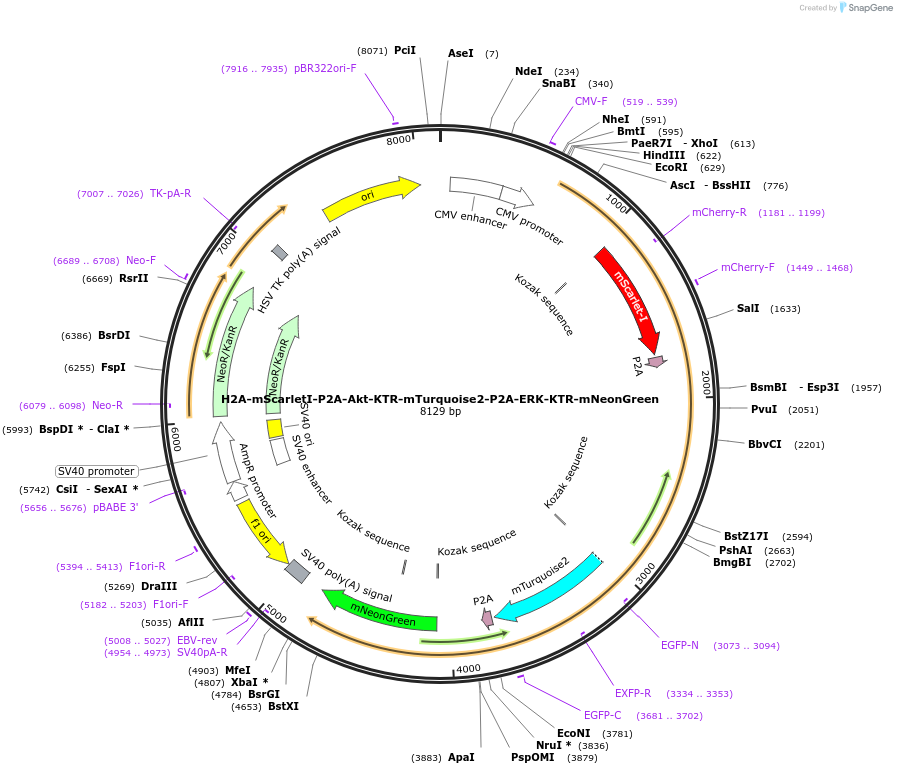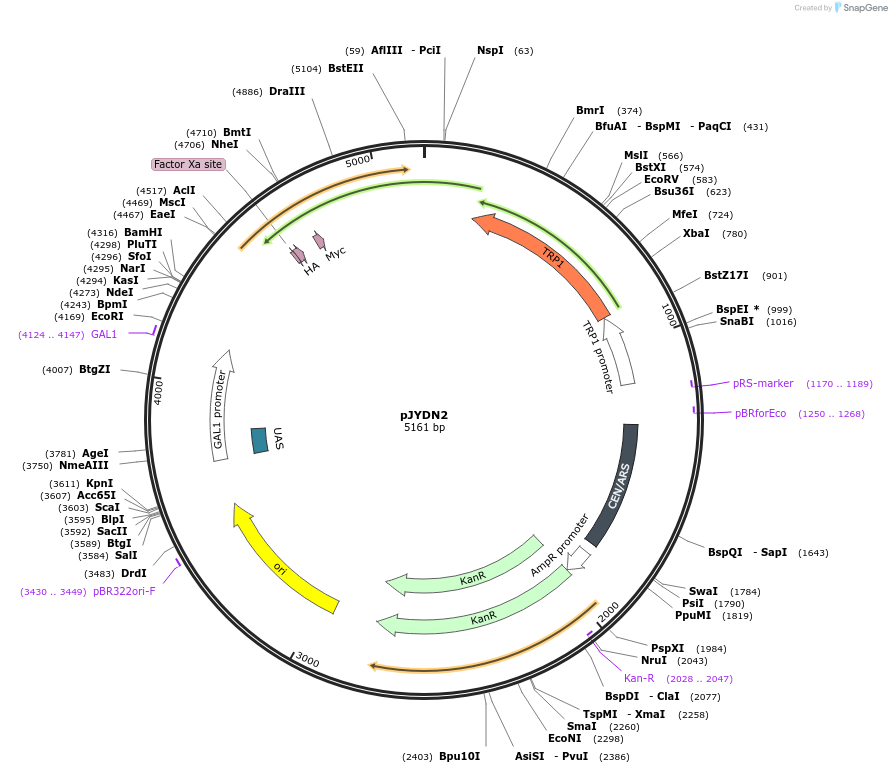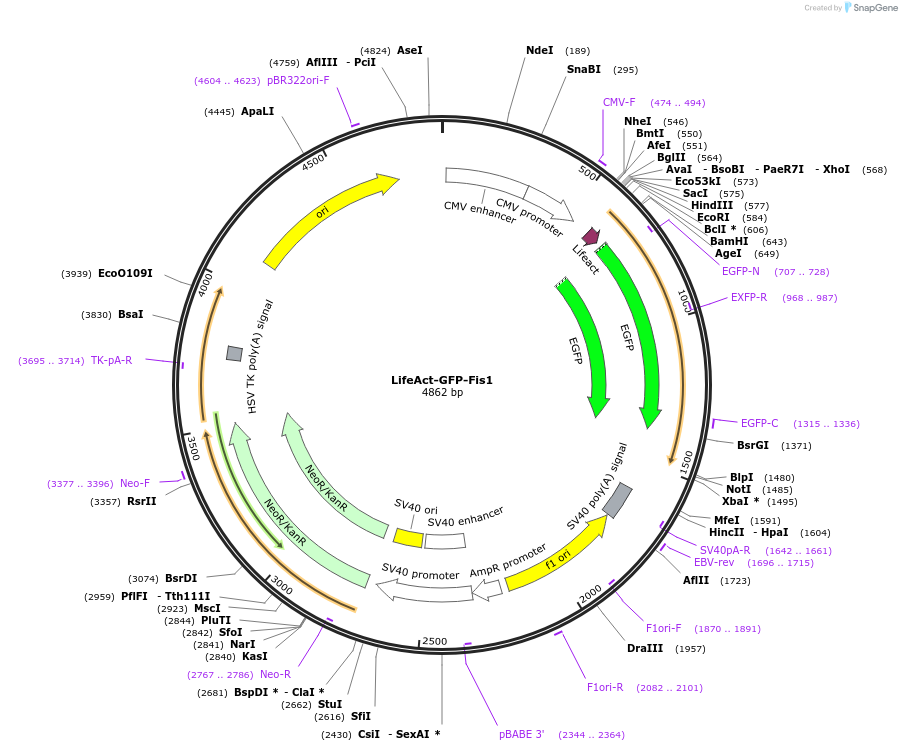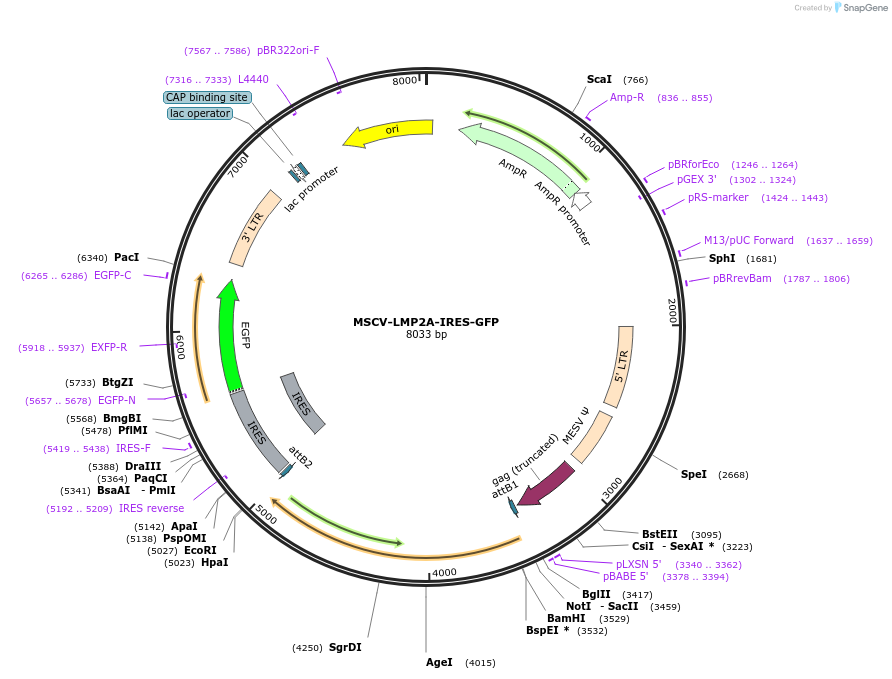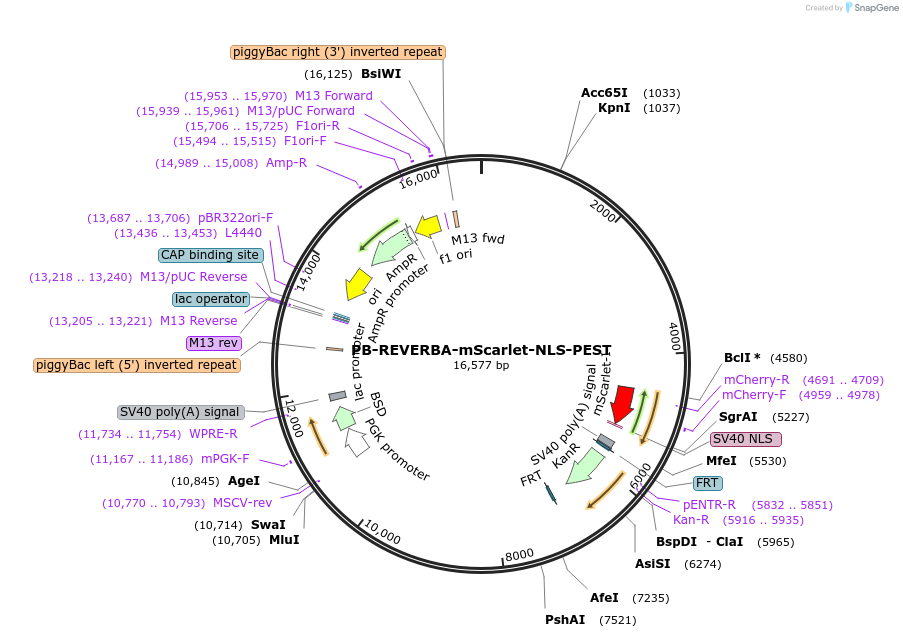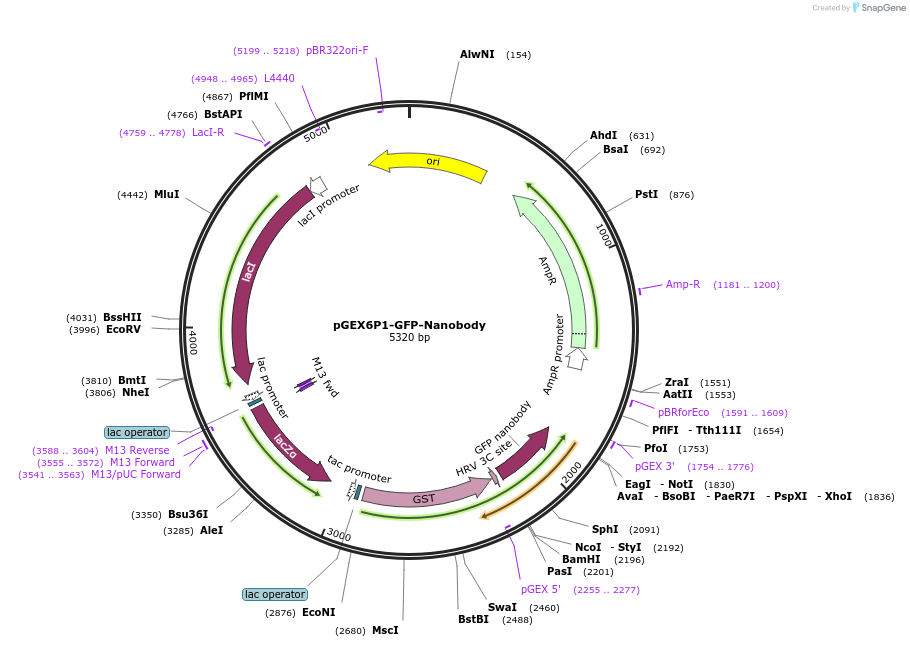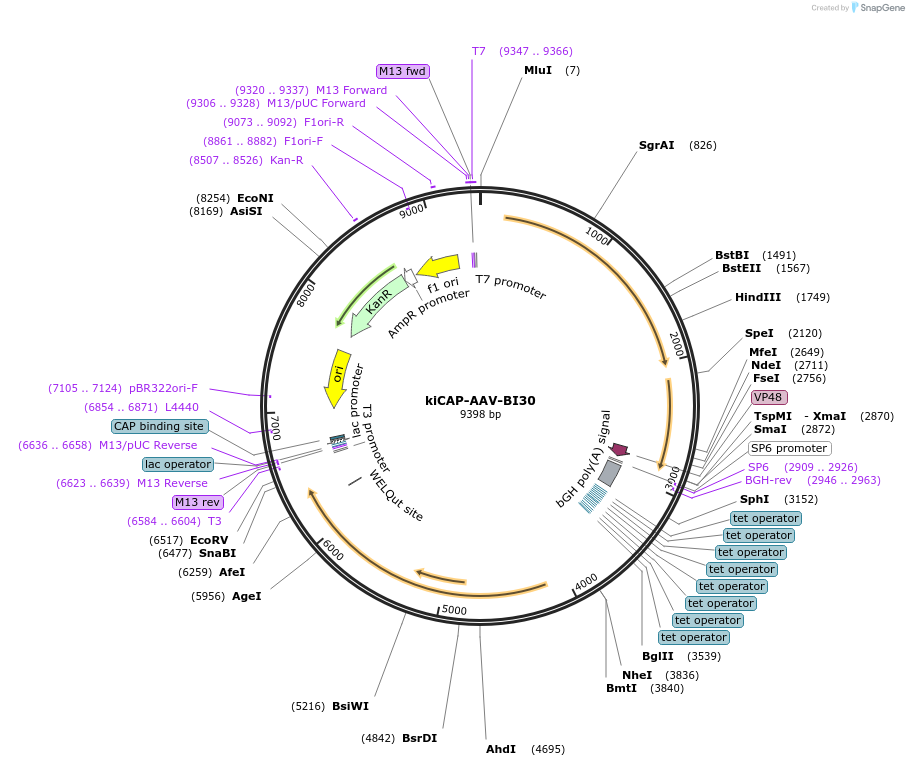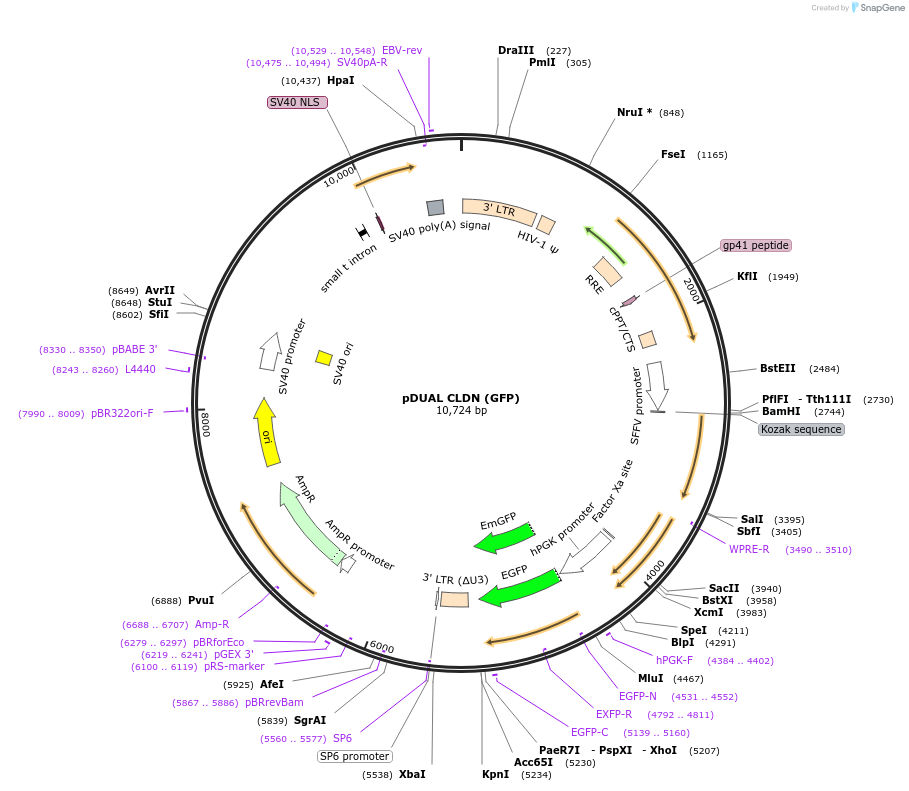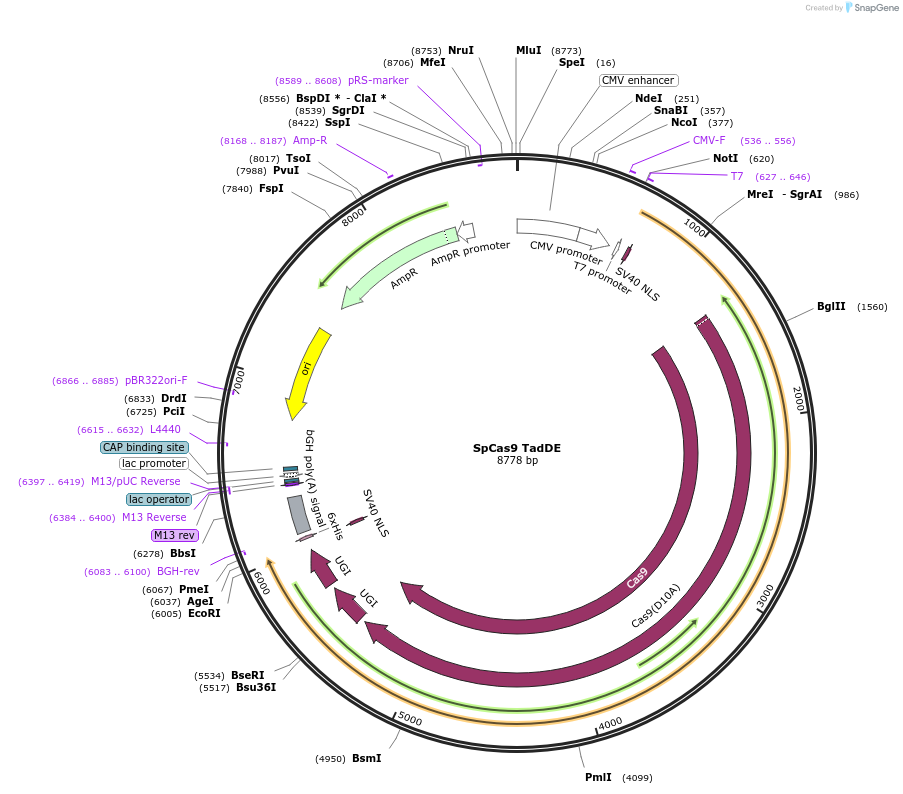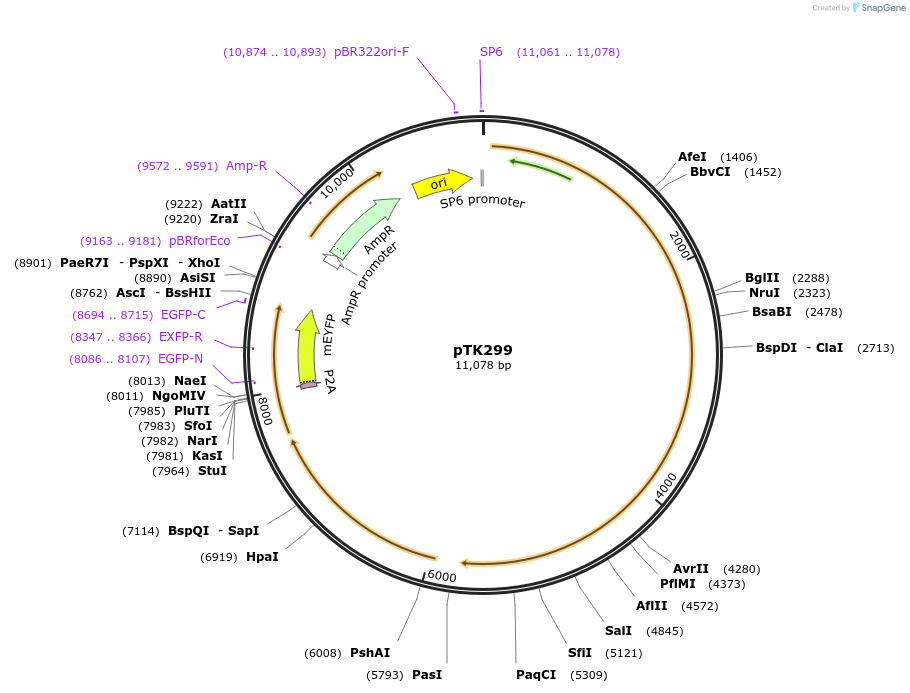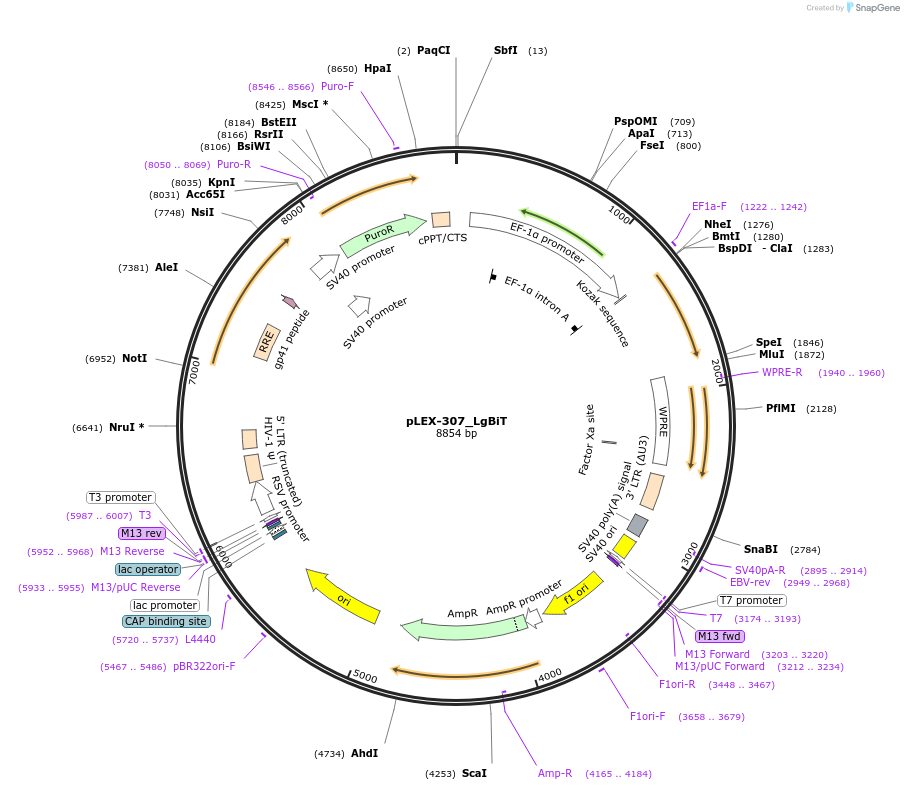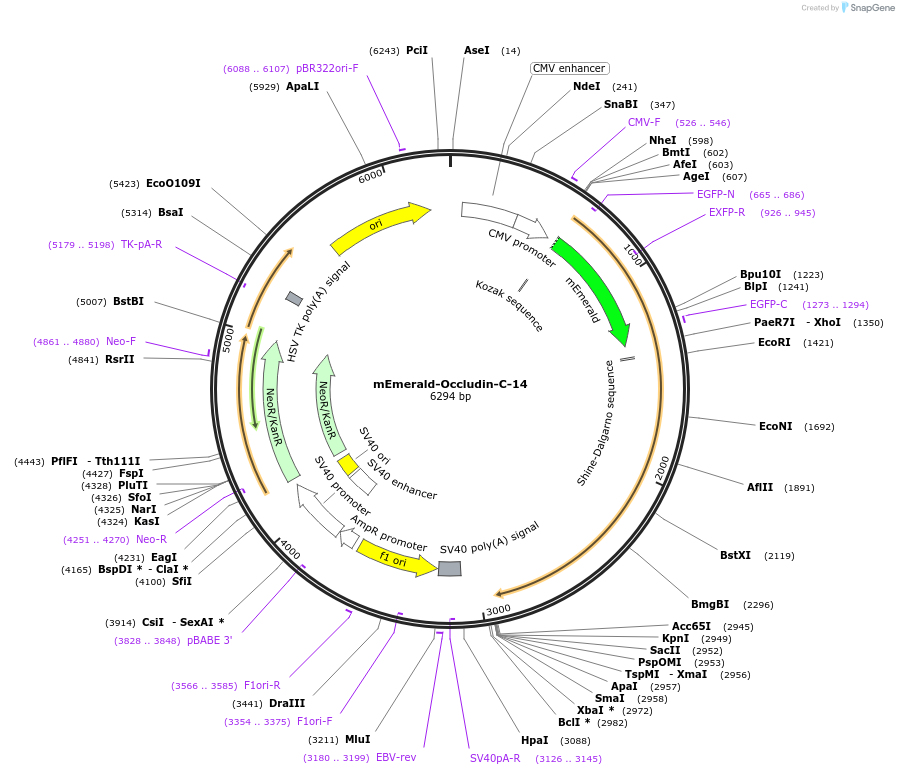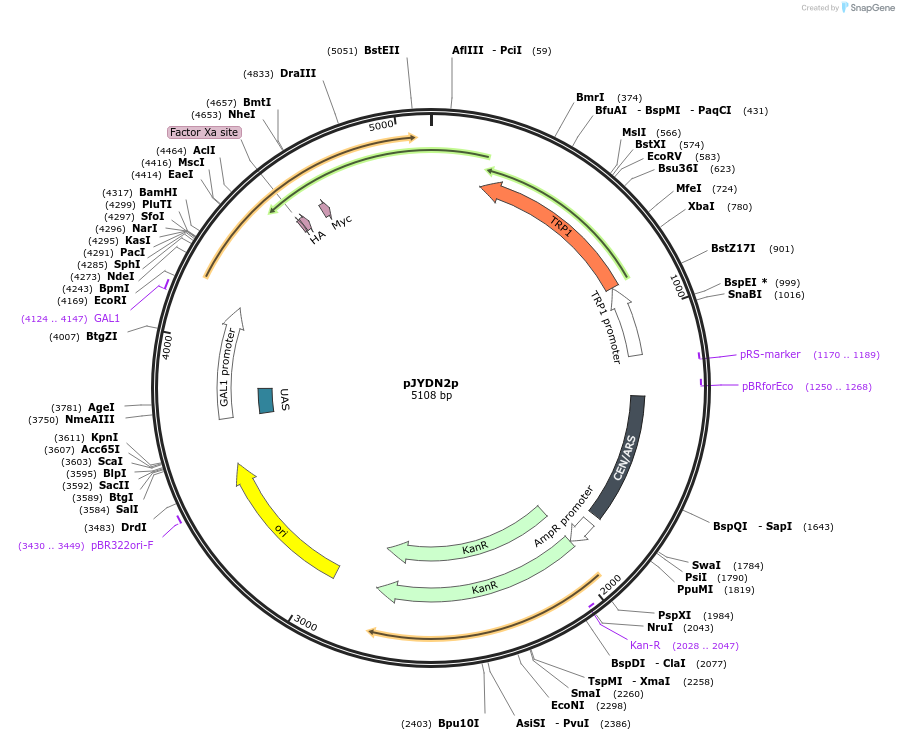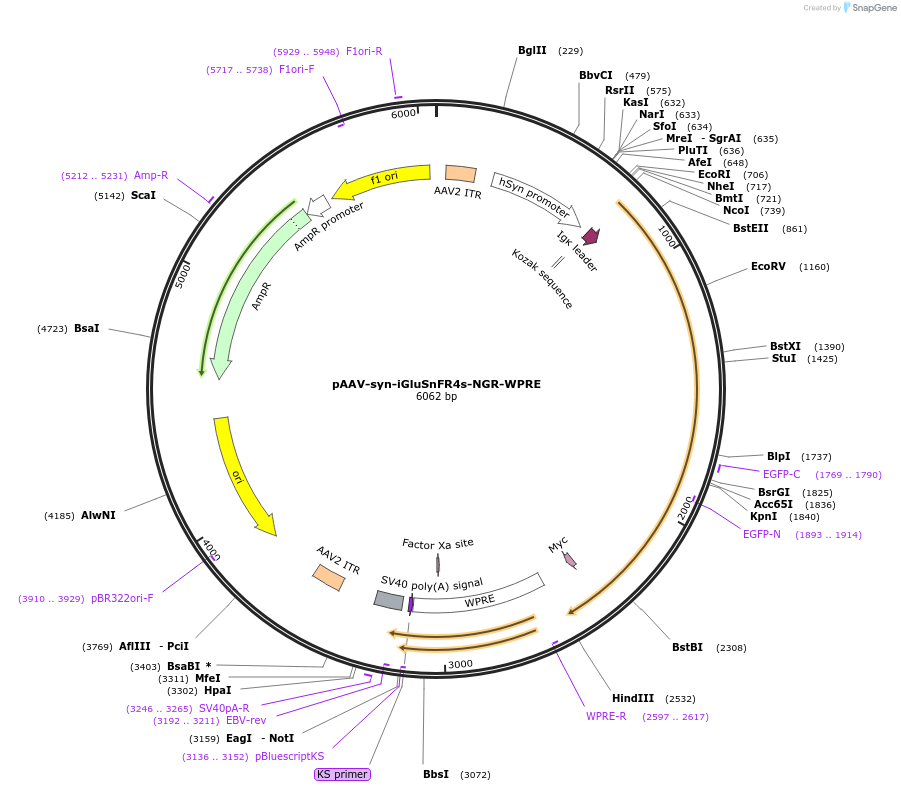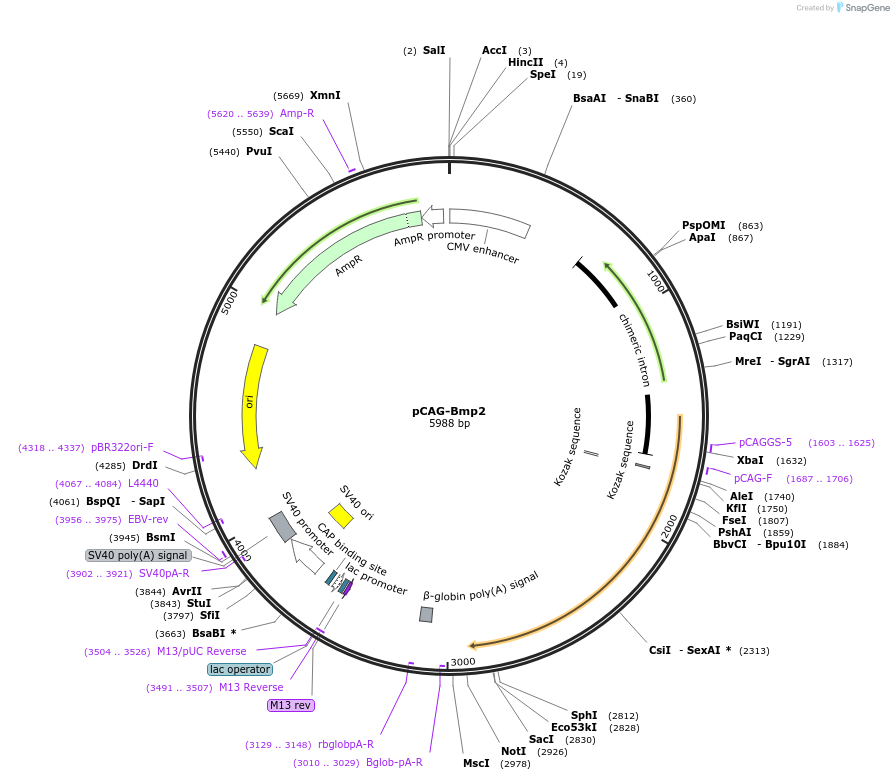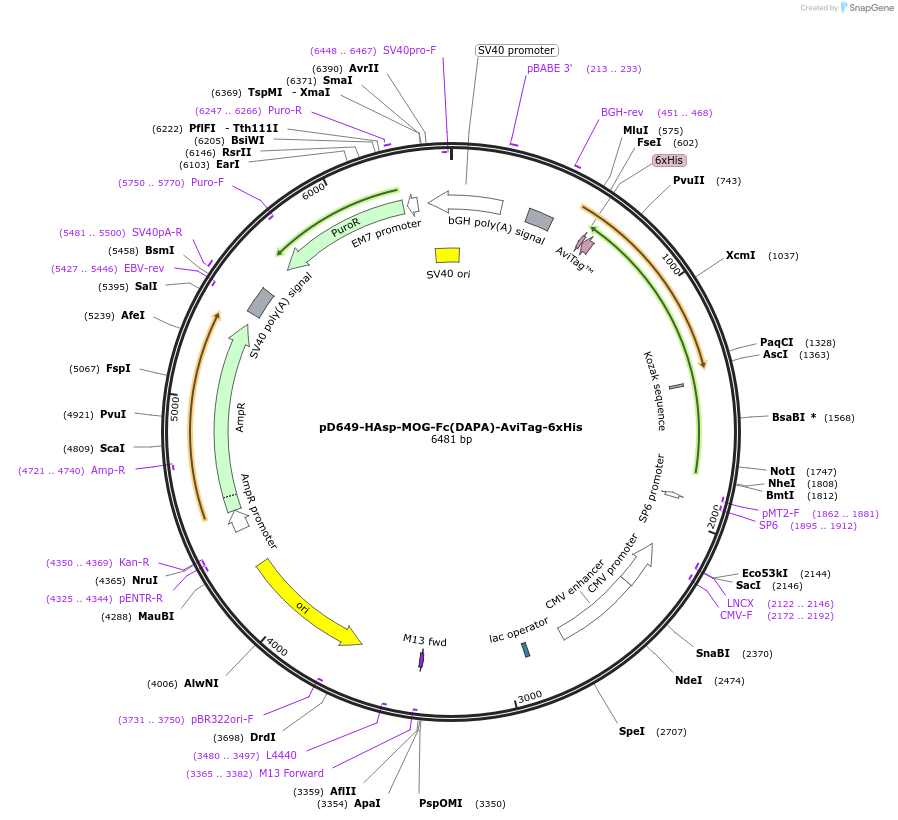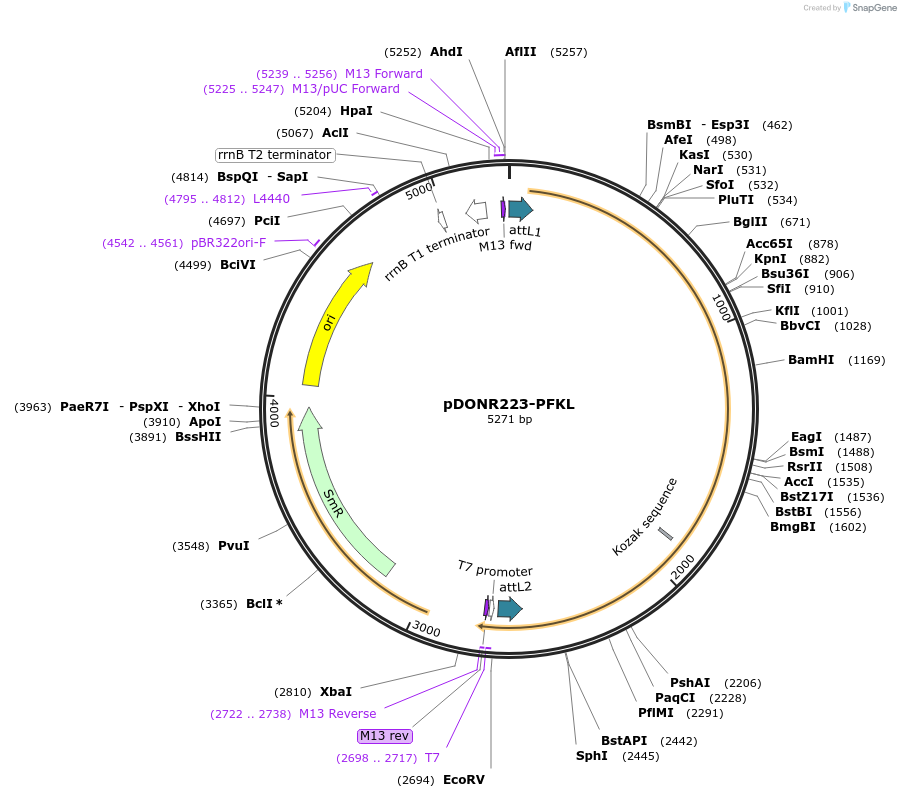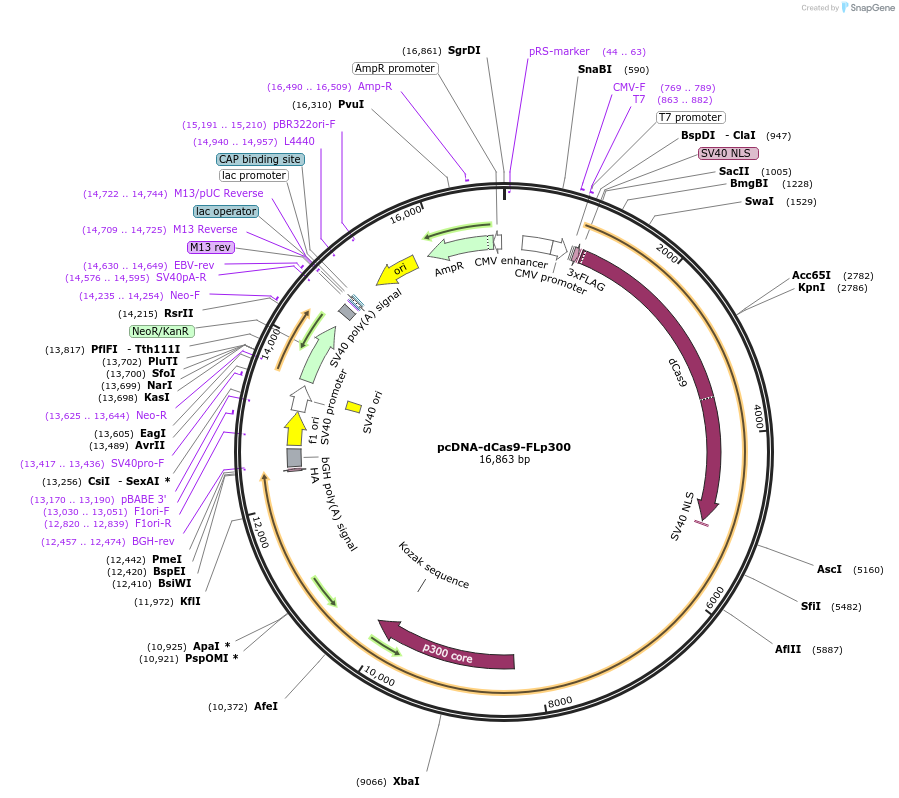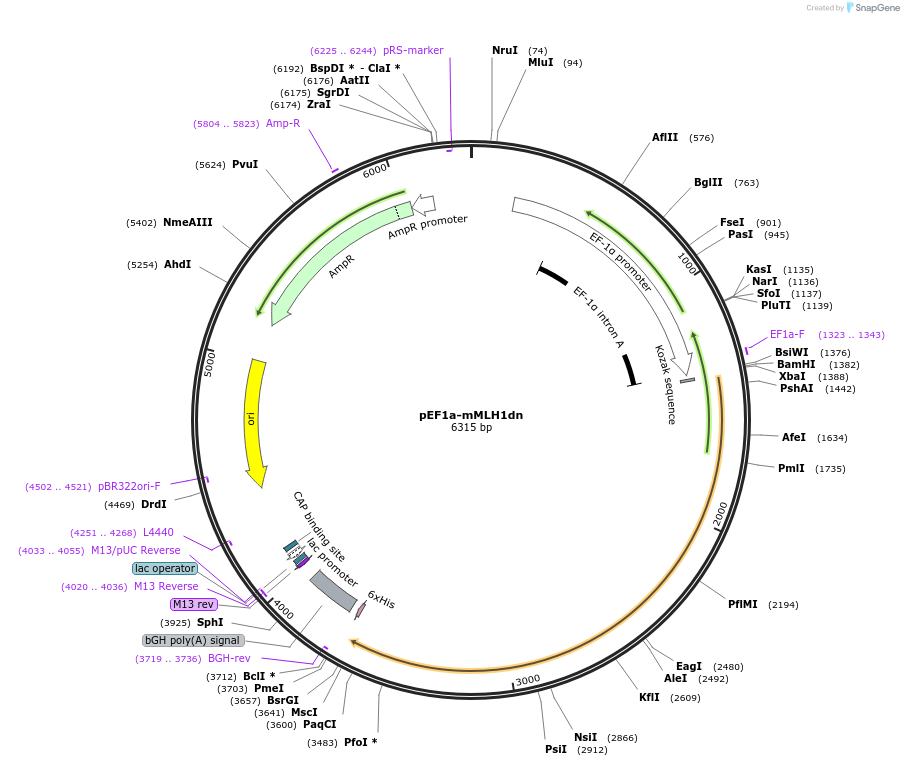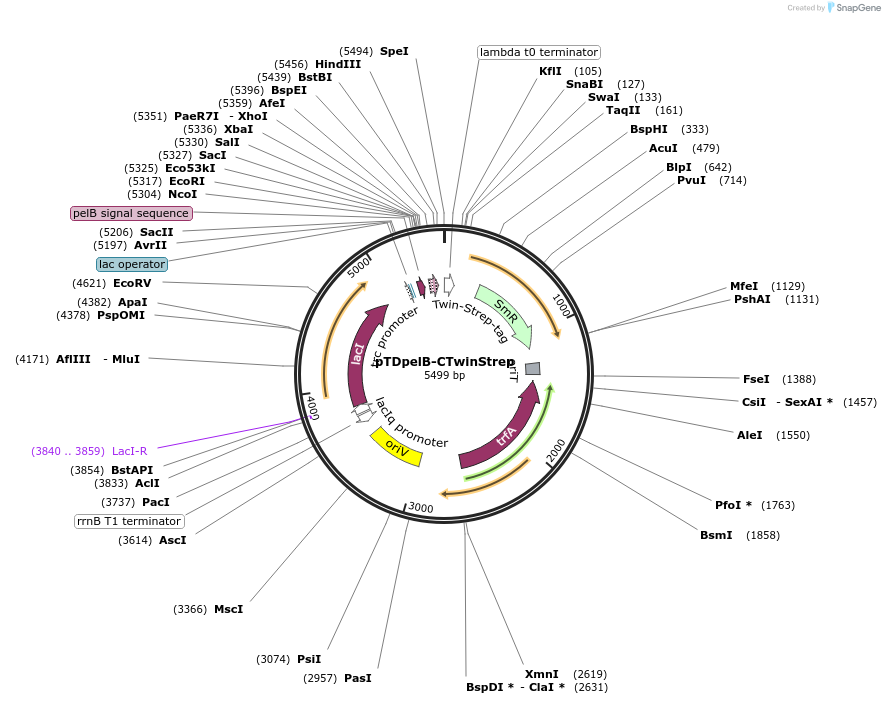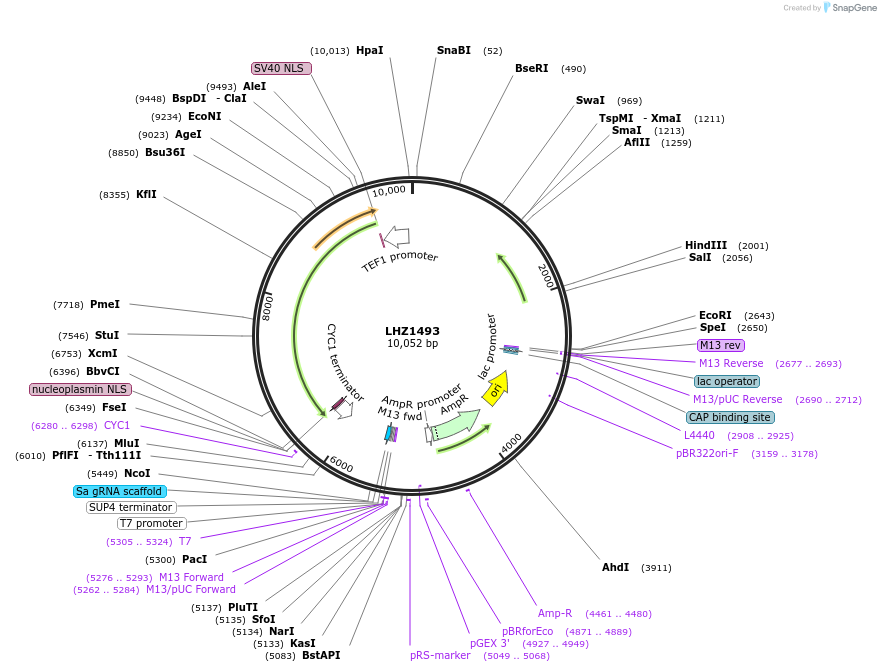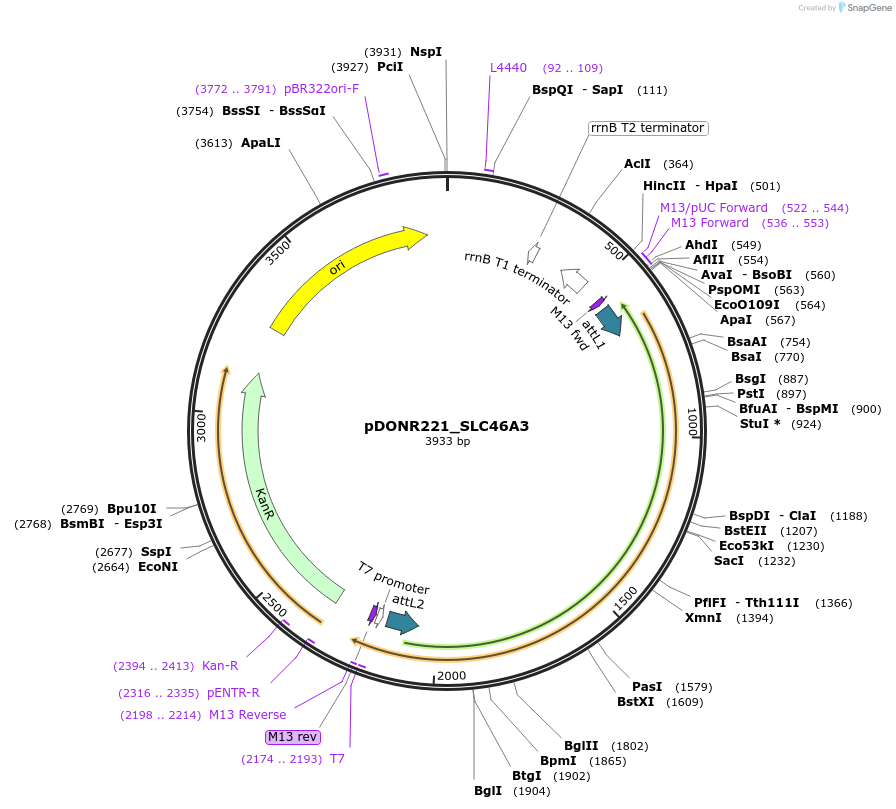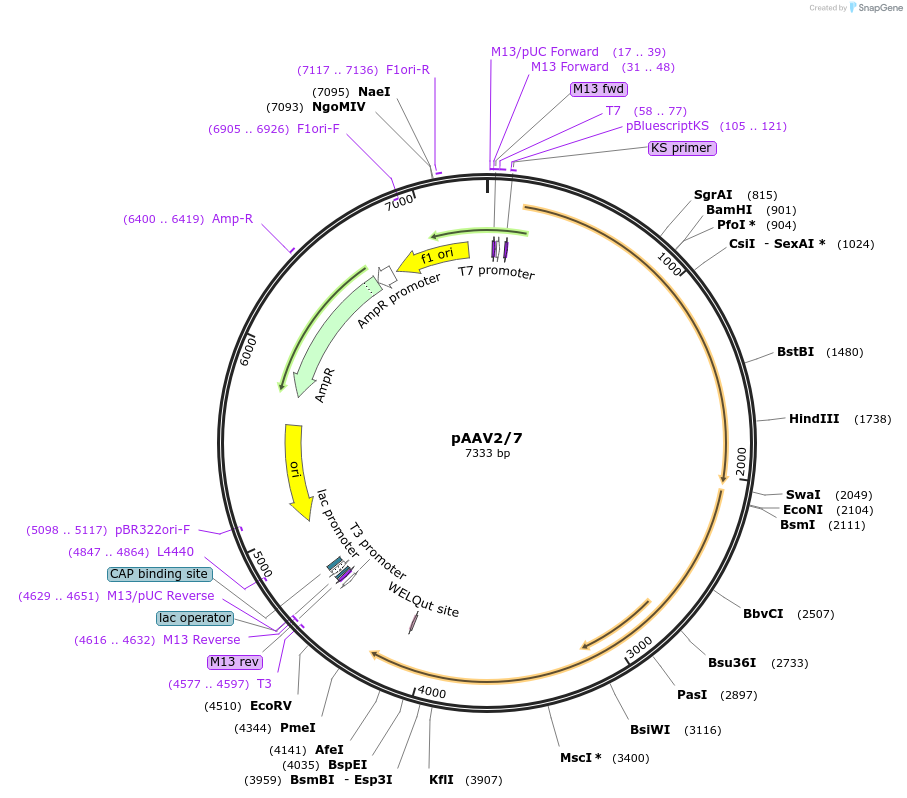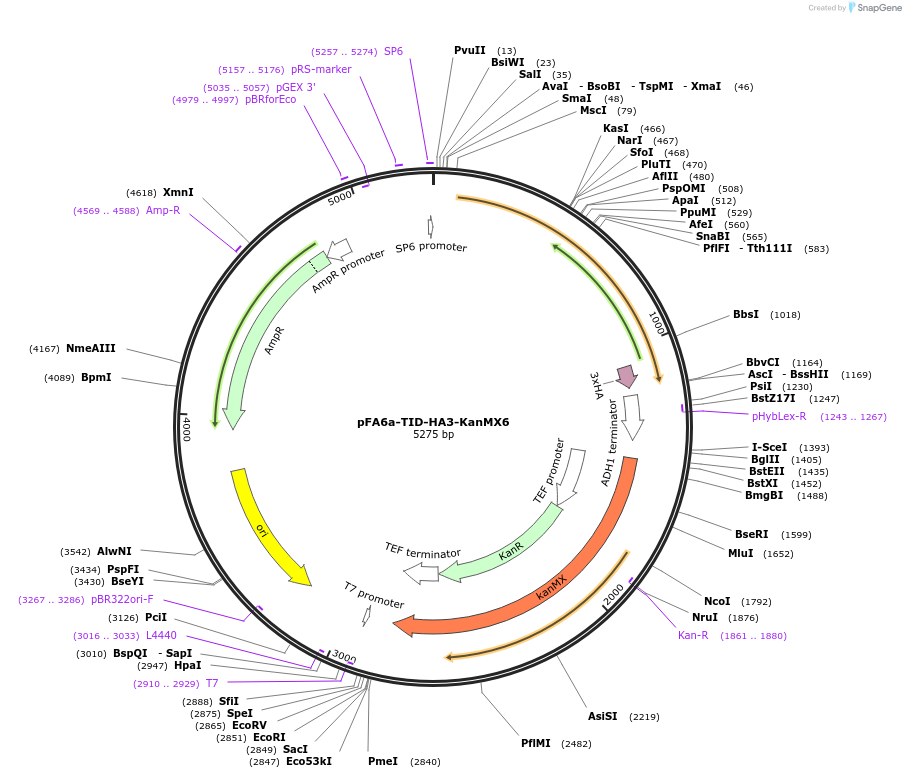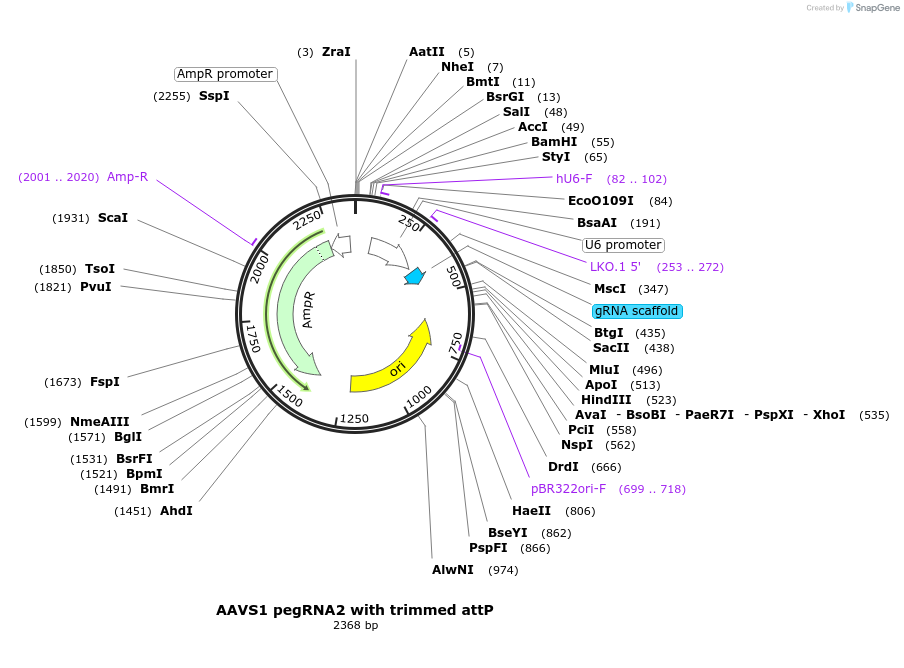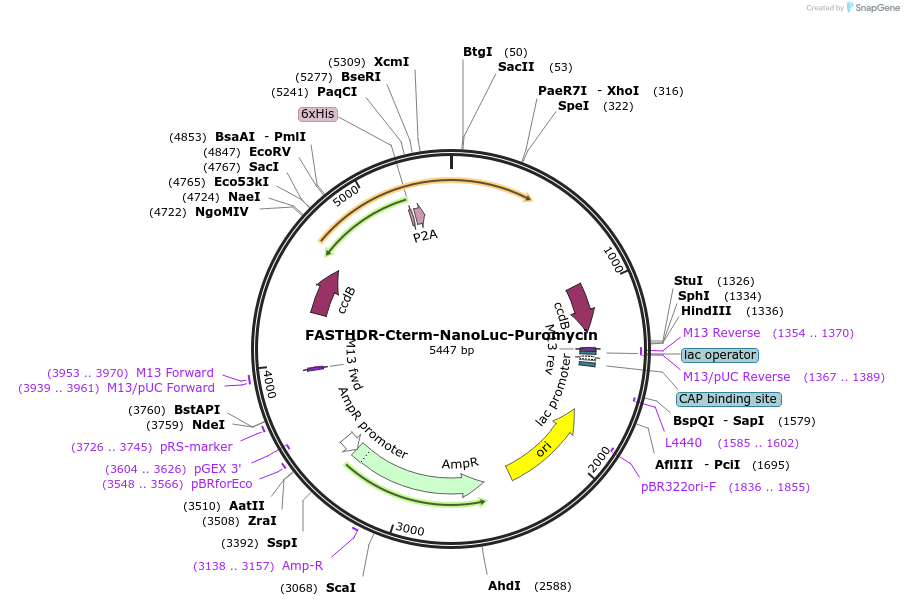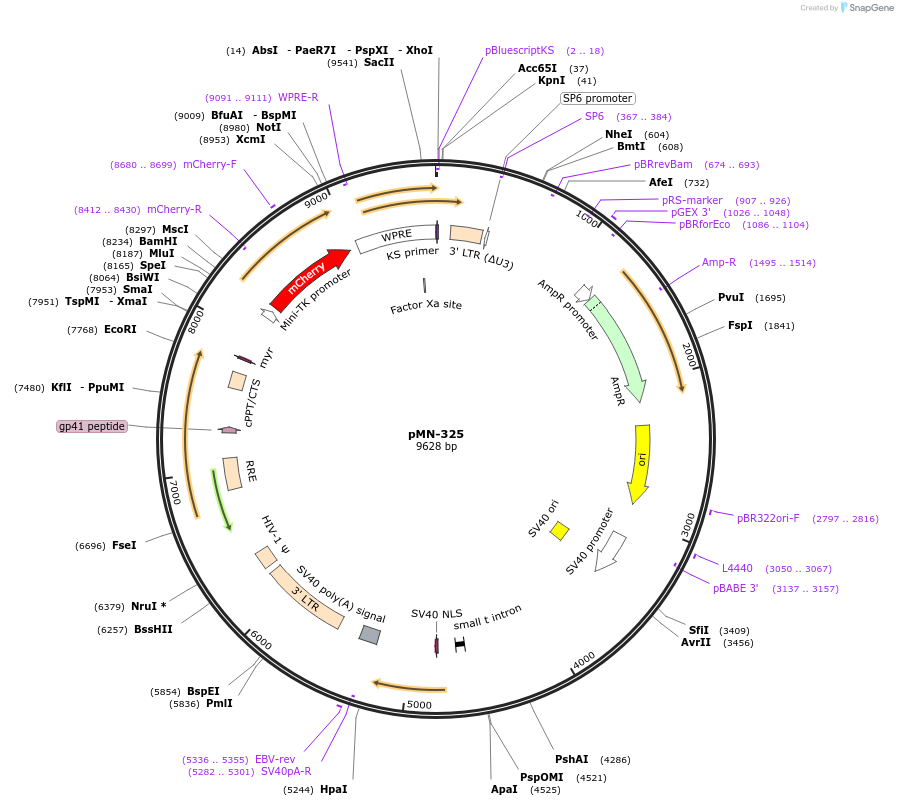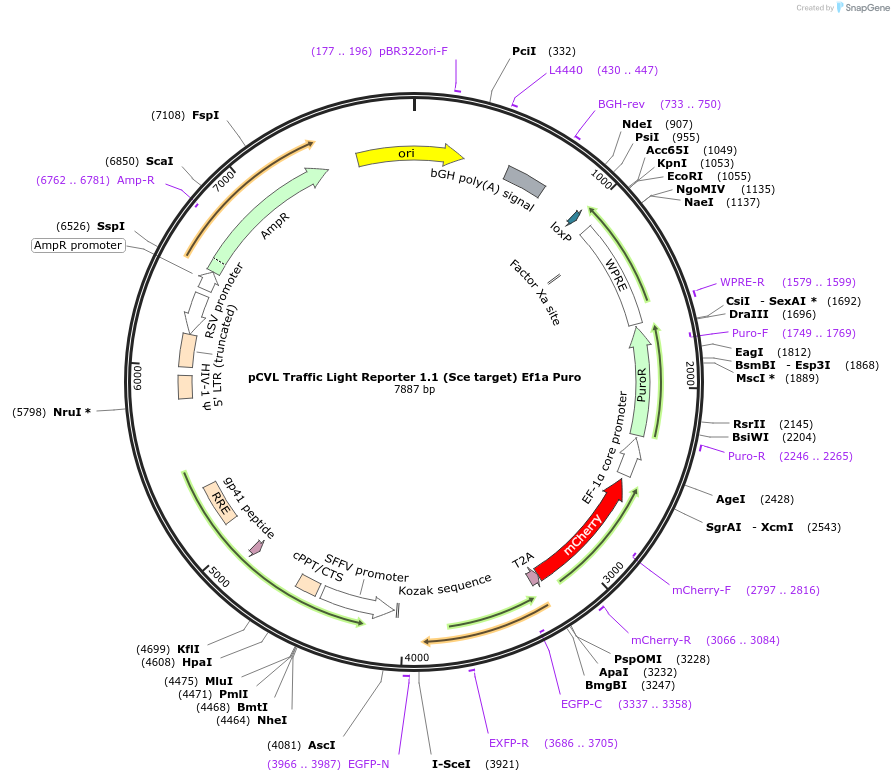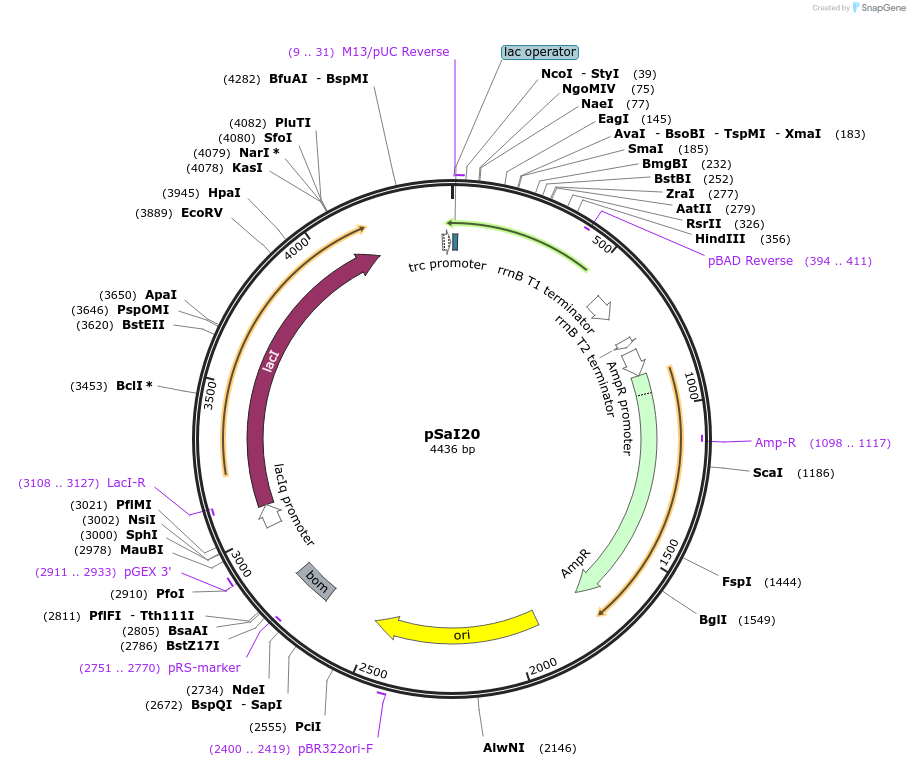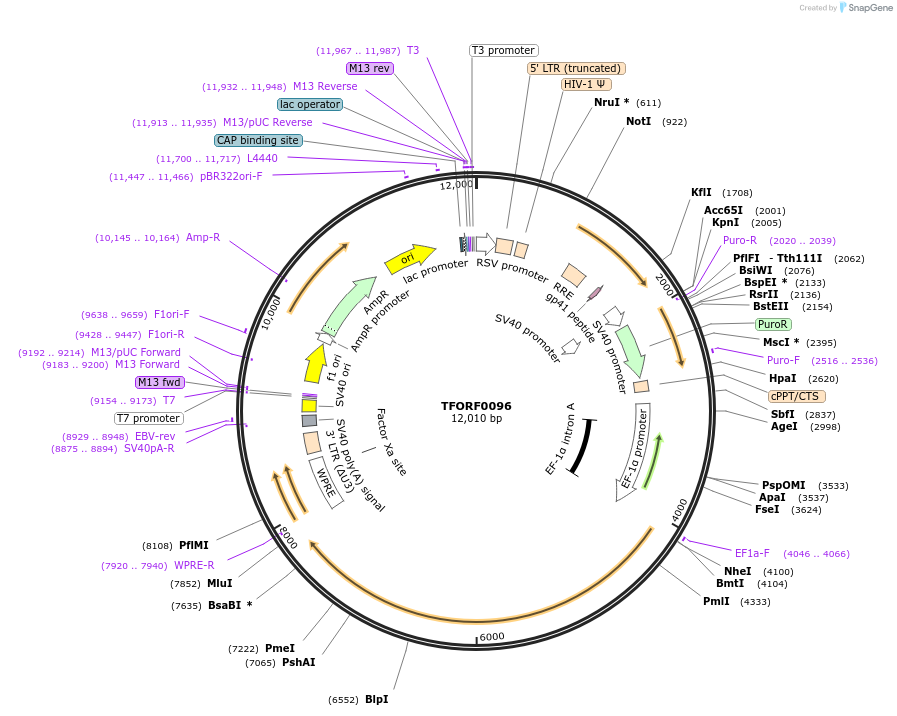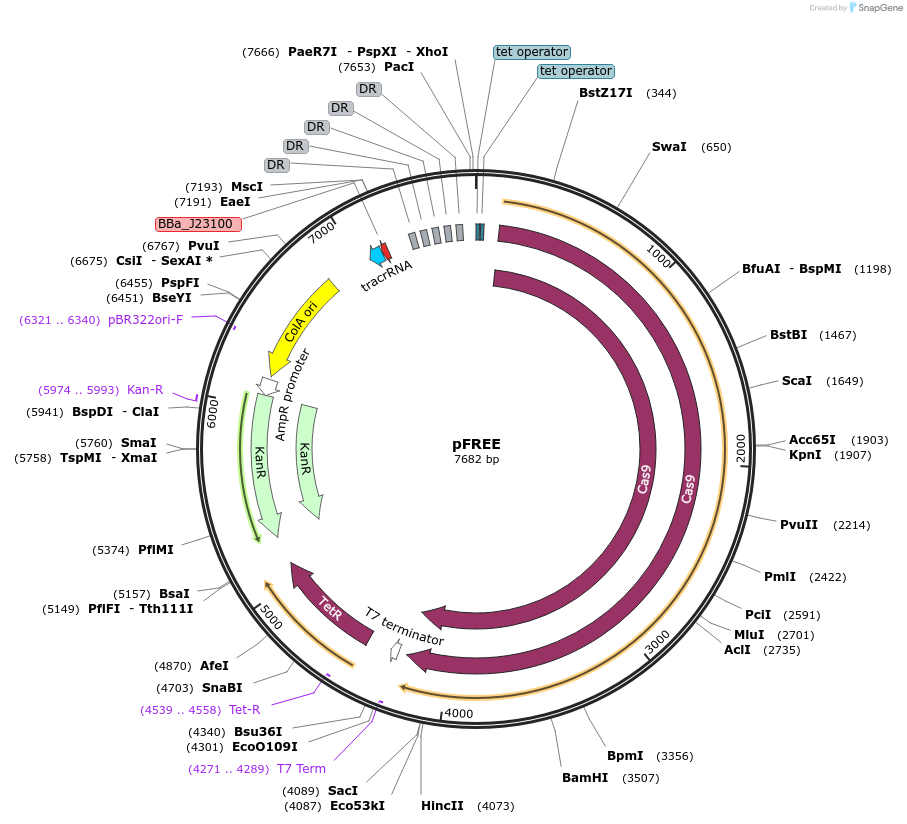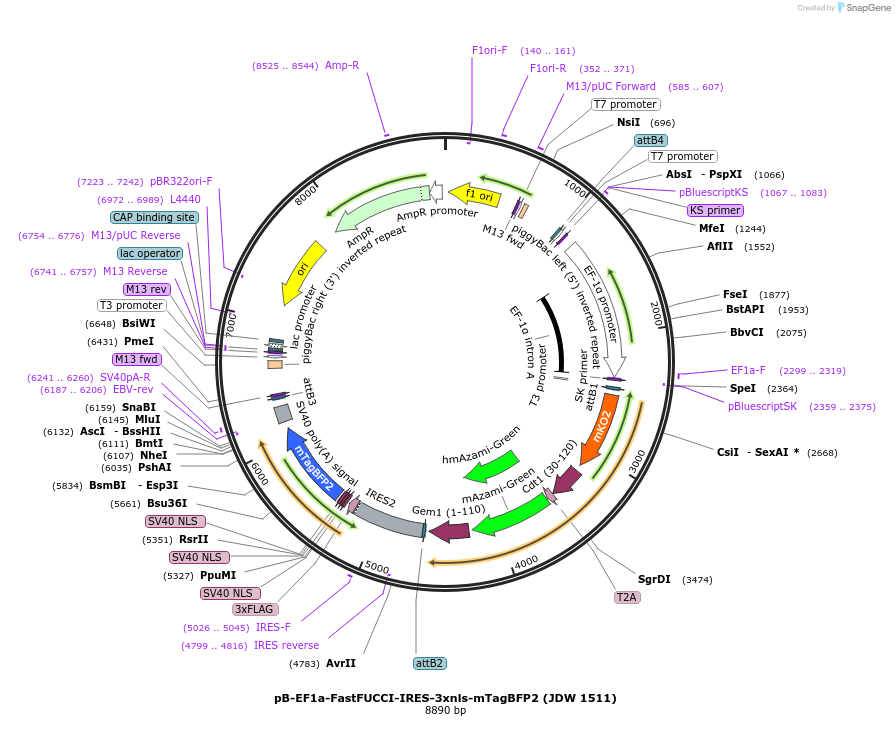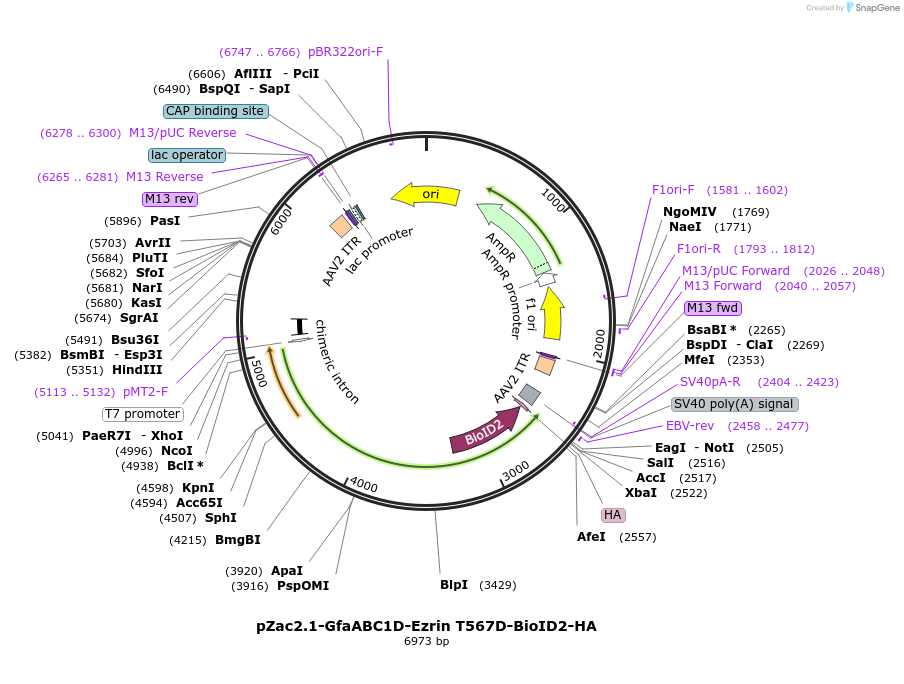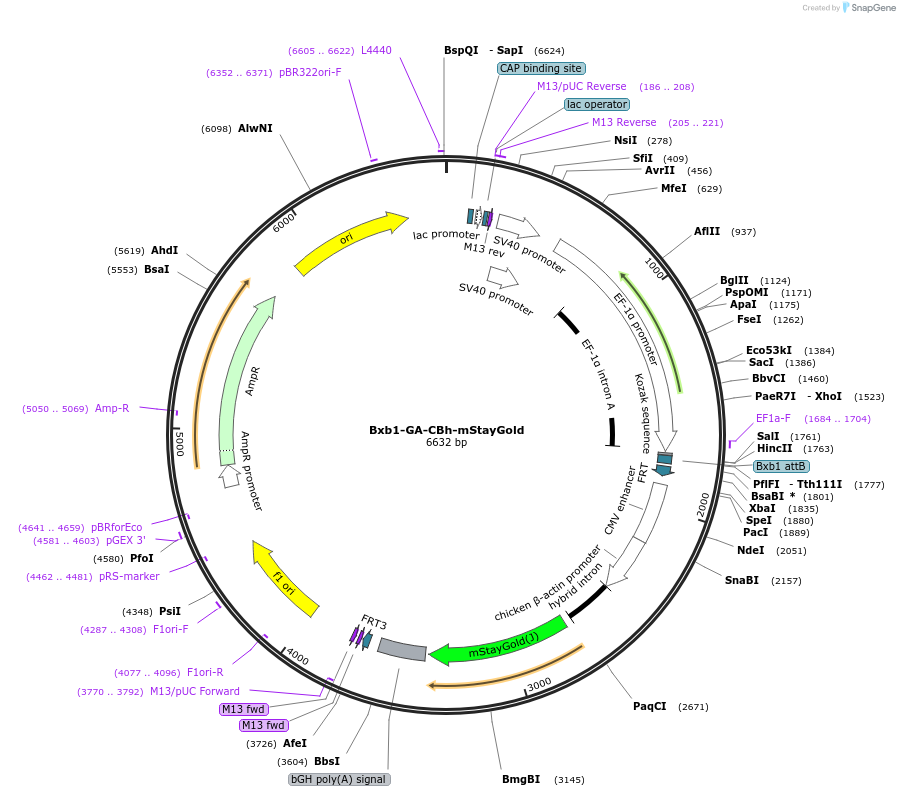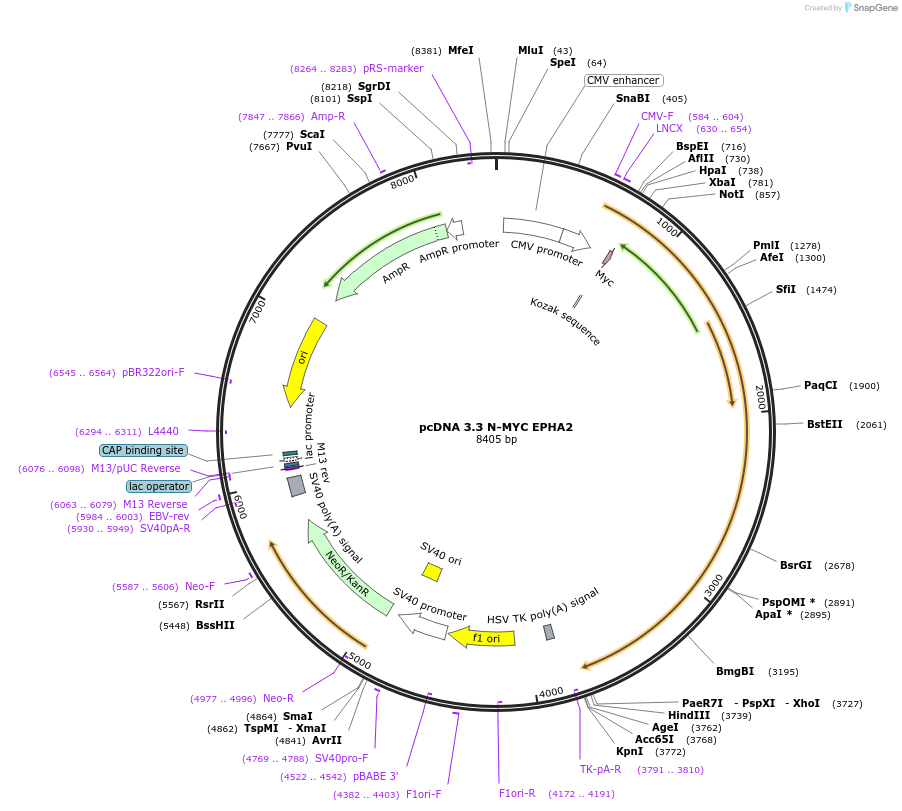169,450 results
-
Plasmid#17736DepositorInsertNLS-Cre recombinase
UseCre/LoxExpressionBacterialAvailable SinceApril 14, 2008AvailabilityAcademic Institutions and Nonprofits only -
pAAV-Ef1a-DIO EYFP (AAV9)
Viral Prep#27056-AAV9PurposeReady-to-use AAV9 particles produced from pAAV-Ef1a-DIO EYFP (#27056). In addition to the viral particles, you will also receive purified pAAV-Ef1a-DIO EYFP plasmid DNA. EF1a-driven, cre-dependent EYFP expression. These AAV preparations are suitable purity for injection into animals.DepositorTagsEYFP (Cre-dependent)Available SinceMarch 7, 2018AvailabilityAcademic Institutions and Nonprofits only -
pAAV-CaMKIIa-mScarlet (AAV8)
Viral Prep#131000-AAV8PurposeReady-to-use AAV8 particles produced from pAAV-CaMKIIa-mScarlet (#131000). In addition to the viral particles, you will also receive purified pAAV-CaMKIIa-mScarlet plasmid DNA. CamKIIa-driven expression of mScarlet. These AAV preparations are suitable purity for injection into animals.DepositorPromoterCaMKIITagsmScarletAvailable SinceSept. 27, 2023AvailabilityAcademic Institutions and Nonprofits only -
pcDNA3.nucGAP
Plasmid#78736PurposeExpression of Ca2+ sensor GAP in the nucleusDepositorInsertnucGAP
Tagsnucleoplasmin (Xenopus)ExpressionMammalianPromoterCMVAvailable SinceJuly 21, 2016AvailabilityAcademic Institutions and Nonprofits only -
H2A-mScarletI-P2A-Akt-KTR-mTurquoise2-P2A-ERK-KTR-mNeonGreen
Plasmid#129631PurposeVisualization of Akt and ERK activityDepositorInsertH2A-mScarletI-P2A-Akt-KTR-mTurquoise2-P2A-ERK-KTR-mNeonGreen
ExpressionMammalianPromoterCMVAvailable SinceJuly 28, 2021AvailabilityAcademic Institutions and Nonprofits only -
pJYDN2
Plasmid#162454PurposeYeast display plasmid intended for co-cultivation labeling by using designed ALFA-tag binding nanobody (DnbALFA) and expression of N-terminal fusions with Aga2p yeast agglutinin.DepositorTypeEmpty backboneUseShuttle vector bacteria/yeastTagsDnbALFA nanobody and Ha and mycAvailable SinceFeb. 19, 2021AvailabilityAcademic Institutions and Nonprofits only -
LifeAct-GFP-Fis1
Plasmid#182576PurposeExpresses LifeAct-GFP targeted to the outer mitochondrial membrane via the Fis1 tail anchor sequenceDepositorInsertLifeAct-GFP-Fis1
TagsFis1 and LifeActExpressionMammalianAvailable SinceApril 7, 2022AvailabilityAcademic Institutions and Nonprofits only -
MSCV-LMP2A-IRES-GFP
Plasmid#220352PurposeExpresses EBV latent gene LMP2A in mammalian cellsDepositorAvailable SinceJune 25, 2024AvailabilityAcademic Institutions and Nonprofits only -
PB-REVERBA-mScarlet-NLS-PEST
Plasmid#190658PurposeFluorescent reporter for circadian rhythmsDepositorInsertReverba-mScarlet (Nr1d1 Mouse)
ExpressionMammalianAvailable SinceSept. 22, 2022AvailabilityAcademic Institutions and Nonprofits only -
pGEX6P1-GFP-Nanobody
Plasmid#61838PurposeExpresses GST-tagged anti-GFP Nanobody in E. coli cells.DepositorInsertGFP-Nanobody
TagsGSTExpressionBacterialAvailable SinceMay 11, 2015AvailabilityAcademic Institutions and Nonprofits only -
kiCAP-AAV-BI30
Plasmid#183749PurposeAAV-BI30 Rep-Cap plasmid for production of AAV-BI30, a capsid with tropism for CNS endothelial cells.DepositorInsertAAV9 modified with 7mer insertion between amino acids 588 and 589 of VP1
UseAAVMutationK449R, and NNSTRGG inserted between 588 and 589 o…Promoterp41Available SinceApril 19, 2022AvailabilityAcademic Institutions and Nonprofits only -
pDUAL CLDN (GFP)
Plasmid#86981PurposeLentiviral expression construct encoding Claudin-1 and GFP from separate promotersDepositorAvailable SinceFeb. 28, 2017AvailabilityAcademic Institutions and Nonprofits only -
SpCas9 TadDE
Plasmid#193837PurposeExpress TadDE (with SpCas9) in mammalian cellsDepositorInsertTadA-DualEditor-Cas9D10A-2xUGI
ExpressionMammalianAvailable SinceDec. 15, 2022AvailabilityAcademic Institutions and Nonprofits only -
pTK299
Plasmid#59568PurposeSIN SP6 P1234 (nsP2 P726S) SGP(14) Kozak L7Ae-P2A-EYFP 4xFF4DepositorInsertSGP(14) Kozak L7Ae-P2A-EYFP 4xFF4
Available SinceAug. 3, 2015AvailabilityAcademic Institutions and Nonprofits only -
pLEX-307_LgBiT
Plasmid#191211PurposeLentiviral-mediated stable expression of LgBiT for slit nanoluciferase complementation assays in mammalian cellsDepositorInsertLgBiT (large bit)
UseLentiviral and LuciferaseMutationAB030246.1 (mutated in PMID 26569370)Available SinceApril 30, 2025AvailabilityAcademic Institutions and Nonprofits only -
mEmerald-Occludin-C-14
Plasmid#54211PurposeLocalization: Tight Junctions, Excitation: 487, Emission: 509DepositorAvailable SinceJune 16, 2014AvailabilityIndustry, Academic Institutions, and Nonprofits -
pJYDN2p
Plasmid#162455PurposePositive control plasmid for co-cultivation labeling by using designed ALFA-tag binding nanobody (DnbALFA).DepositorInsertAga2p-DnbALFA (AGA2 )
UseShuttle vector bacteria/yeastTagsDnbALFA nanobody and HA and mycPromoterGAL1Available SinceFeb. 19, 2021AvailabilityAcademic Institutions and Nonprofits only -
pAAV-syn-iGluSnFR4s-NGR-WPRE
Plasmid#234437PurposeAAV-mediated expression of glutamate sensor with improved sensitivity and slow deactivation kinetics (4s = slow); NGR vector matches or outperforms PDGFR in all conditions tested.DepositorHas ServiceAAV1InsertiGluSnFR4s-NGR
UseAAVTagsIgK chain and Myc epi tag-NGR GPI anchorExpressionMammalianPromoterSynapsinAvailable SinceMarch 20, 2025AvailabilityAcademic Institutions and Nonprofits only -
-
pD649-HAsp-MOG-Fc(DAPA)-AviTag-6xHis
Plasmid#156506PurposeMammalian expression of cell-surface protein extracellular domain fused to Fc(DAPA)-Avi-6xHis. Protein is secreted from cells.DepositorInsertMOG (MOG Human)
TagsFc(DAPA)-AviTag-6xHisExpressionMammalianMutationFc region of human IgG contains D265A and P329A m…PromoterCMV/SP6Available SinceAug. 5, 2022AvailabilityAcademic Institutions and Nonprofits only -
pDONR223-PFKL
Plasmid#23729DepositorInsertPFKL (PFKL Human)
UseGateway donor vectorAvailable SinceJuly 30, 2010AvailabilityAcademic Institutions and Nonprofits only -
pDONR223 CASP1[CARD]-mSG2 (inflammasome reporter)
Plasmid#228043PurposeDONR vector for inflammasome speck reporter, designed from PMC9623368.DepositorInsertCASP1[CARD]-mSG2
UseGateway donrAvailable SinceOct. 28, 2024AvailabilityAcademic Institutions and Nonprofits only -
pcDNA-dCas9-FLp300
Plasmid#61356Purposeencodes S. pyogenes dCas9 with c-terminal fusion of FL human p300 (aa 2-2414) driven by CMV promoterDepositorInsertS.pyogenes dCas9 with c-terminal full length human p300 (aa 2-2414) (EP300 S. pyogenes, Synthetic, Human)
UseCRISPR and Synthetic BiologyTagsFlag, HA, and SV40 NLSExpressionMammalianMutationD10A; H840A in S.pyogenes Cas9PromoterCMVAvailable SinceApril 16, 2015AvailabilityAcademic Institutions and Nonprofits only -
pEF1a-mMLH1dn
Plasmid#174825PurposeMammalian expression of mouse MLH1dn (codon optimized)DepositorInsertmouse MLH1dn (codon optimized)
ExpressionMammalianMutationdeletion of residues 758-760PromoterEF1aAvailable SinceOct. 14, 2021AvailabilityAcademic Institutions and Nonprofits only -
pTDpelB-CTwinStrep
Plasmid#45941Purposeuse to create N-terminal PelB and C-terminal Twin-Strep-tagged fusion proteins for periplasmic translocation via PelB signal sequenceDepositorTypeEmpty backboneTagsPelB and Twin-StrepExpressionBacterialPromoterTrc (lactose/IPTG inducible)Available SinceSept. 18, 2013AvailabilityAcademic Institutions and Nonprofits only -
ePPE-spG
Plasmid#183096PurposeFor plant prime editing in rice plants or monocotyledons protoplastsDepositorInsertNls-nspGCas9-NC-nls-MLV-Nls
UseCRISPRExpressionPlantMutationD10A in SpGCas9Available SinceApril 6, 2022AvailabilityAcademic Institutions and Nonprofits only -
-
pGL2-200bp
Plasmid#16293DepositorInsertp53 promoter fragment (TP53 Human)
UseLuciferaseExpressionMammalianMutationfragment -188 to +12 relative to first transcript…Available SinceDec. 14, 2007AvailabilityAcademic Institutions and Nonprofits only -
LHZ1493
Plasmid#222102PurposeCloning backbone for sgRNA in Kluyveromyces marxianus. Expresses highly specific SlugCas9.DepositorTypeEmpty backboneUseCRISPRExpressionYeastAvailable SinceAug. 1, 2024AvailabilityAcademic Institutions and Nonprofits only -
pDONR221_SLC46A3
Plasmid#132215PurposeGateway entry clone with codon-optimized ORF sequence for subcloning into custom expression vectorsDepositorInsertSLC46A3 (SLC46A3 Human)
ExpressionMammalianAvailable SinceNov. 4, 2019AvailabilityIndustry, Academic Institutions, and Nonprofits -
pAAV2/7
Plasmid#112863PurposeAAV packaging plasmid expressing Rep/Cap genesDepositorInsertRep2/Cap7
UseAAVPromoterTruncated P5Available SinceSept. 11, 2018AvailabilityAcademic Institutions and Nonprofits only -
mCerulean-C1
Plasmid#54592PurposeLocalization: C1 Cloning Vector, Excitation: 433, Emission: 475DepositorTypeEmpty backboneTagsmCeruleanExpressionMammalianAvailable SinceJuly 25, 2014AvailabilityAcademic Institutions and Nonprofits only -
pFA6a-TID-HA3-KanMX6
Plasmid#227980PurposeTo insert biotin ligase, TurboID, at the C-terminus of genes; yeast BioID, KanMX6 markerDepositorInsertTurboID
TagsHA tagExpressionYeastAvailable SinceNov. 11, 2024AvailabilityAcademic Institutions and Nonprofits only -
GreenGate
Plasmid Kit#1000000036PurposeGolden Gate cloning system for rapid assembly of plant transformation constructs; Uses 6 types of pre-cloned modules: promoter, N- and C-terminal tags, coding sequence, terminator, resistance cassetteDepositorAvailable SinceOct. 29, 2013AvailabilityAcademic Institutions and Nonprofits only -
AAVS1 pegRNA2 with trimmed attP
Plasmid#222347PurposepegRNA 2 plasmid used for PASSIGE-mediated Bxb1 attP installationDepositorInsertAAVS1 attP-installation pegRNA2
UseCRISPRAvailable SinceJune 27, 2024AvailabilityAcademic Institutions and Nonprofits only -
FASTHDR-Cterm-NanoLuc-Puromycin
Plasmid#167209PurposePlasmid to clone recombination arms to create homologous recombination donor vector for C-terminal gene tagging with NanoLuc and selection with PuromycinDepositorTypeEmpty backboneUseCRISPRTagsNanoLucExpressionMammalianAvailable SinceDec. 8, 2021AvailabilityAcademic Institutions and Nonprofits only -
pMN-325
Plasmid#195450PurposeLentiviral Integratable mCherry Reporter for synZiFTR ZF1DepositorInsert8X ZF1 BS - minTK - mCherry
UseLentiviralExpressionMammalianAvailable SinceMarch 3, 2023AvailabilityAcademic Institutions and Nonprofits only -
pSaI14
Plasmid#8614DepositorInsertRibonuclease inhibitor SaI14
ExpressionBacterialMutationN terminal threonine changed to alanineAvailable SinceJan. 17, 2007AvailabilityAcademic Institutions and Nonprofits only -
pLenti-mCherry-Mango II x 24
Plasmid#127587PurposeExpresses the mCherry-Mango II x 24 array from a TetON responsive promoterDepositorInsertmCherry-Mango II x24
TagsmCherryExpressionMammalianPromoterpTRE Tet ONAvailable SinceMarch 9, 2020AvailabilityAcademic Institutions and Nonprofits only -
pCVL Traffic Light Reporter 1.1 (Sce target) Ef1a Puro
Plasmid#31482DepositorInsertTraffic Light Reporter 1.1 (Sce Target) EF Puro
UseLentiviralMutationmCherry has M9S and M16L mutations. This is what …Available SinceAug. 18, 2011AvailabilityAcademic Institutions and Nonprofits only -
pSaI20
Plasmid#8615DepositorInsertRibonuclease inhibitor SaI20
ExpressionBacterialMutationN terminal threnine changed to alanineAvailable SinceJan. 17, 2007AvailabilityAcademic Institutions and Nonprofits only -
TFORF0096
Plasmid#142459PurposeLentiviral vector for overexpressing transcription factor ORFs with unique 24-bp barcodes. Barcodes facilitate identification of transcription factors in pooled screens.DepositorAvailable SinceDec. 2, 2024AvailabilityAcademic Institutions and Nonprofits only -
pFREE
Plasmid#92050PurposeAllows inducible expression of gRNAs and Cas9 for plasmid curing.DepositorInsertsCas9
gRNA array
UseCRISPRExpressionBacterialPromoterpRhamBAD and ptetAvailable SinceJuly 21, 2017AvailabilityAcademic Institutions and Nonprofits only -
Antibody#241896-rAbPurposeAnti-PUNC (Human) chimeric recombinant antibody with fused human variable and rabbit constant domains; recognizes human and mouse PUNC. Does not cross-react with related family members DCC, NEO, PRTG.DepositorArticleRecommended ApplicationsFlow Cytometry and ImmunocytochemistryReactivityHuman and MouseSource SpeciesRabbitIsotypeIgGTrial SizeNot available to purchaseAvailable SinceDec. 17, 2025AvailabilityIndustry, Academic Institutions, and Nonprofits
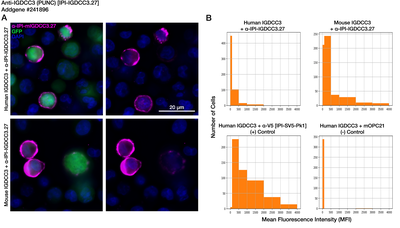
-
Antibody#241897-rAbPurposeAnti-PUNC (Mouse) chimeric recombinant antibody with fused human variable and rabbit constant domains; recognizes mouse and human PUNC. Does not cross-react with related family members DCC, NEO, PRTG.DepositorArticleRecommended ApplicationsFlow Cytometry and ImmunocytochemistryReactivityHuman and MouseSource SpeciesRabbitIsotypeIgGTrial SizeNot available to purchaseAvailable SinceDec. 17, 2025AvailabilityIndustry, Academic Institutions, and Nonprofits
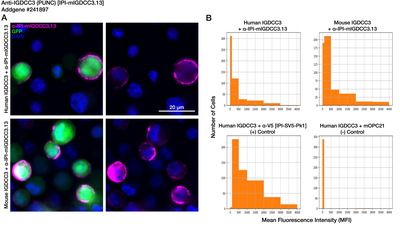
-
pB-EF1a-FastFUCCI-IRES-3xnls-mTagBFP2 (JDW 1511)
Plasmid#242599PurposeA PiggyBac expression vector containing the human EF1a promoter driving FastFUCCI to label cell cycle state followed by an IRES-3xnls-mTagBFP2.DepositorInsertmKO2-hCDT1(30-120) T2A mAG-hGEM(1-110) (EEF1A1 Human)
ExpressionMammalianPromoterhuman EF1aAvailable SinceDec. 16, 2025AvailabilityAcademic Institutions and Nonprofits only -
INS-CRa-Lsg-MS2
Plasmid#247478PurposesgRNA for INS activation cloned into LsgRNA-MS2 backboneDepositorAvailable SinceOct. 23, 2025AvailabilityAcademic Institutions and Nonprofits only -
pZac2.1-GfaABC1D-Ezrin T567D-BioID2-HA
Plasmid#227682PurposeTo over express Phospho-mimetic Ezrin under gfaABC1D promoter in astrocytesDepositorAvailable SinceOct. 1, 2025AvailabilityAcademic Institutions and Nonprofits only -
Bxb1-GA-CBh-mStayGold
Plasmid#241379PurposeBxb1-GA donor plasmid for integrating a transcription unit for constitutive expression of mStayGold with CBh promoterDepositorInsertmStayGold
ExpressionMammalianPromoterCBhAvailable SinceSept. 15, 2025AvailabilityAcademic Institutions and Nonprofits only -
pcDNA 3.3 N-MYC EPHA2
Plasmid#227879PurposeUsed for transfection of cells for expression of C-MYC EPHA2DepositorAvailable SinceJune 30, 2025AvailabilityAcademic Institutions and Nonprofits only



